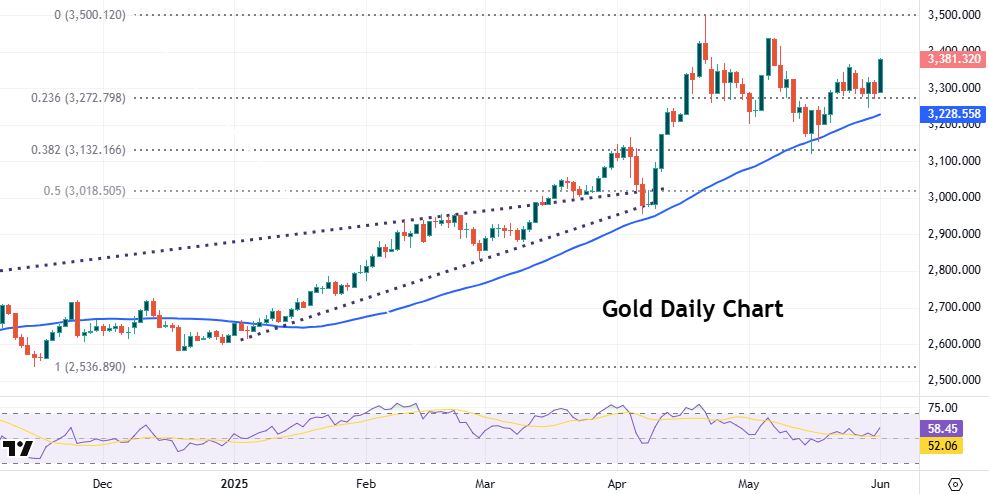Dollar nears 2022 lows again on US-China flare up

- USD sinks on tariff worries as President Trump lashes out against Beijing
- Nasdaq and big tech lead stocks higher on reports of Trump-Xi talks
- Gold rises on safe haven demand and a weaker dollar
- Oil jumps as OPEC+ confirms July output hike
FX: USD saw big losses to kick off June hitting six-week lows, as trade worries intensified between the US and China. President Trump had taken aim at China late last week, noting how they are violating their agreement. Beijing equally accused the US of violating the consensus reached in Geneva, warning they might take additional action to defend their interests. The flaring up of trade‐related tensions caused sharp dollar selling, with an initial risk‐off bias. Weak US ISM manufacturing, which fell to 48.5, also didn’t support the greenback. This simply highlighted that high uncertainty relating to trade policies continued to disrupt supply chains.
EUR pushed higher as it performed mid-pack compared to its currency peers. The recent three-year top is at 1.1572. Dollar selling is seeing flows into the single currency, as we have said before. There was little reaction to mixed final manufacturing PMI figures. The ECB is fully expected to cut rates on Thursday. Focus will be on today’s inflation data.
GBP benefitted from the weak dollar with recent consolidation looking bullish as cable approaches the recent high at 1.3592. There’s not a lot of UK data this week, so sterling will be moved by trade developments. We get to hear from some Bank of England policymakers today at the Treasury Committee meeting.
USD/JPY sold off for a third day in a row, as it neared last week’s low at 142.10. Risk aversion saw the yen strengthen, though it lagged the Antipodeans. Japan Economic Minister Akazawa said the latest round of trade discussions have them on track towards a deal as early as this month. But he stated that there was no change in the US stance on tariffs, including those on auto parts, which was regrettable.
AUD jumped on upside in base metals, trading towards the top of the range around 0.65, which includes the 200-day SMA at 0.6448. NZD led the major currencies as it tried to break out decisively above 0.60. CAD was stronger for a third straight day posting a new low for the move at 1.3673, though the loonie underperformed other majors. The BoC meeting is not likely to bring another rate cut while jobs data is released on Friday.
US stocks: US stocks closed in the green. The S&P 500 added 0.41% to settle at 5,936. The Nasdaq closed up 0.71% at 21,492. The Dow Jones finished higher by 0.08% at 42,305. Only one sector finished in negative territory – industrials, while energy and tech led the gainers. Brent crude surged over 3.8% as Ukraine/Russia tensions escalated over the weekend, OPEC+ agreed to lift output and there were updates from Iran. White House sources hinted late in the session that Presidents Trump and Xi could speak very soon. Treasury Secretary Bessent had also hinted at upcoming talks between the two leaders. Several steel and aluminium stocks advanced after Trump said he planned to double duties on metal imports.
Asian stocks: Futures are mixed. Asian markets were mostly in the red as trade uncertainty and negative weekend headlines hit sentiment. The Hang Seng underperformed on mixed PMI data and tit-for-tat trade accusations between the US and China. The Shanghai Composite was closed. The Nikkei 225 slumped on the open with currency strength not helping. The ASX 200 was relatively rangebound though miners and commodity sectors were soft amid trade war ructions.
Day Ahead – Eurozone CPI
Consensus expects headline eurozone inflation to rise to 2% in May, down from the prior 2.2% and hitting the ECB’s inflation target. This is partially driven by lower energy prices and a lower core – that is seen ticking down to 2.5% from 2.7%. The April increase in core inflation was based on a late Easter this year and that should be reversed. That said, some economists had expected the core to remain sticky at prior levels. But this was before the marked moderation seen in Spain’s core figure, although it might be offset by the stickiness seen in the German number.
Going forward, headline inflation may continue to fall due to lower energy prices and euro appreciation. These two factors could more than offset any tariff impact. This data may not have too much sway on this week’s ECB meeting which begins on Wednesday. Another 25bps rate cut is fully priced more or less but things are much less clear going into the summer.
Chart of the Day –Gold to new highs?
A new month has kicked off with bullion looking to break higher as a sinking dollar and haven demand boosted demand. The global trade war, geopolitical risks and central bank buying have been the key drivers for the precious metal’s impressive 25% rally this year. But reduced recession fears, less aggressive Fed rate cuts and less buying by ETFs and China saw consolidation by bugs last month. A bullish advance can see the all-time top at $3,500 fairly quickly, if prices hold above $3,365. Support is $3,272, a minor Fib retracement level of the November to April rally.

